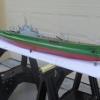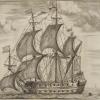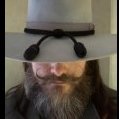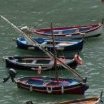-
Posts
3,568 -
Joined
-
Last visited
Reputation Activity
-
 Piet got a reaction from GrandpaPhil in Surabaya by Piet - 1/80 - Mid 17th-Century VOC ship
Piet got a reaction from GrandpaPhil in Surabaya by Piet - 1/80 - Mid 17th-Century VOC ship
Thanks Mark for keeping an eye on little old me.
Well, I’m all caught up to date with the rebuild of my VOC ship log.
My apologies for the screw up with post one, the introduction. I zigged instead of zagged but the rest worked out okay.
In the past week I have tried to put things together but my two left hands in computering caused problems deciphering the intricacies of this new format. Give an airplane to fix or fly then no prob.
Thanks to the input of two friends on the forum I managed to muddle through it.
Okay, I did manage to do some work on the ship. I made two new catheads, 2 two holer potties or as the Dutch call then
“gemak,” and in the Malay language it’s “kakoes.” Perhaps the Dutchies on the forum recognize the origin, “kakhuis.”
This was a perfectly normal name for the old Dutch colonizers, the Indonesian people just adopted it and stick with it till this day. Okay, in the English vernacular it is “shithouse.”
I’m about ready to try my hand at carving the bow lion and dress up that end of the bow.
I also spend some time making room for the build dock for the submarine model, Hr. Ms. O 19. I’ll be working models
together.
Okay, here are three pics and the last one is an opinion request.
The head the two "kakoes."
Head-on view of the bow.
I installed a railing on the waist bullwark and like to have an opinion. I have seen these period ships with these railings painted to match the rest of the ship. or esthetic reasons I think it would look pretty good that way instead of this very light piece in the middle. My "admiral" agrees.
Cheers,
-
 Piet got a reaction from Kevin in Surabaya by Piet - 1/80 - Mid 17th-Century VOC ship
Piet got a reaction from Kevin in Surabaya by Piet - 1/80 - Mid 17th-Century VOC ship
Installment 5.
Fwd bulkhead looks nice but will be removed to open the quarterdeck. The bulkhead behind it will be replaced
with the fwd bulkhead but clinker planked per the suggestion from Amazon Dirk, one of the “Gentlemen Seventeen.”
View looking forward. Forecastle deck beams installed. Capstan will be junked. The helm is installed. The bulkhead
directly in front of the helm will be replaced as noted in previous picture with two doors and a large window for the helm’s man to look outside.
Captain’s furniture.
Captain’s cabin completed as far as I want it to go. His computer, GPS, library, Hi Fi stereo, kitchenette and other convenience items to come later ;-)
Preparation for making pulley blocks for spar deck gun tackle. This is the start and rough first stage. I’m using maple.
Catheads. First generation. Eventually I went through three different ones before I was satisfied - - - and they had to
fit with the head railings. This pair had to be replaced by suggestion from Amazon Dirk.
Reason for the catheads to be replaced is that they are normally fastened to the forecastle deck frames aft of the bulkhead.
Cheers,
-
 Piet got a reaction from Kevin in Surabaya by Piet - 1/80 - Mid 17th-Century VOC ship
Piet got a reaction from Kevin in Surabaya by Piet - 1/80 - Mid 17th-Century VOC ship
Installment 4
Close-up view of planking port side. Ready for sanding.
Orlop deck cargo grating installed.
Captain’s cabin deck installed with two bed cribs and seaman chests and table.
Spar deck beams at the waist installed with carlings.
View through grate opening in spar deck to orlop with ladder.
Door hinge hardware.
Forecastle fwd bulkhead with door and hinges, early stage.
Forecastle fwd bulkhead with doors installed. Deck beams installed with LEDs. Fancy eyebrows over doors.
Cheers,
-
 Piet got a reaction from Kevin in Surabaya by Piet - 1/80 - Mid 17th-Century VOC ship
Piet got a reaction from Kevin in Surabaya by Piet - 1/80 - Mid 17th-Century VOC ship
1665 VOC Ship, installment 2.
The build jig with a seven degree incline for the required drag (stuurlast in Dutch), with the central bulkhead frame in place. Steel 900 angles are screwed to the base of the jig to ensure accuracy. My workbench top is a perfect
horizontal surface both ways and so is the build jig. The cutout is to accommodate a section of individual frames
and an opening in the starboard side of the hull for a view in the hold.
This shows all bulkheads installed with the individual frames waiting. This action was actually an afterthought. Originally I only intended to show the outside with minimal plank on frame construction. I then changed my mind and wanted to
also show more detail such as the hold and the captain and officer’s areas.
All individual frames installed in the waist area.
This shows the deck beam shelves installed for the gun deck and spar deck. I also added extra wood to the
bulkheads for better fairing and glue surface for the planks, and installed
wiring for lights.
Cargo hold ceiling planks installed with simulated deck planking to accommodate the 18
pounder cannons on the gun deck.
Part of the orlop beams with carling cutouts with the carlings in the waist area.
Orlop deck beams with carlings installed. Portions of the frames cut away for visual
access to the hold.
Planking in progress using 2 mm maple planks.
-
 Piet got a reaction from Kevin in Surabaya by Piet - 1/80 - Mid 17th-Century VOC ship
Piet got a reaction from Kevin in Surabaya by Piet - 1/80 - Mid 17th-Century VOC ship
Installment 1
After I completed my self designed model of a Freedom Sloop I wanted to finally tackle my long held desire to build a mid Seventeenth Century VOC ship. (VOC stands for Verenigde OostIndiesche Compagnie or United East-Indies Company, chartered by the Dutch States General in 1602 and dissolved in 1800 due to bankruptcy). I liked the looks of ships of that era best and to honor my father and my wife’s father, both died in the wool seamen. My father wanted to study for seamanship in one of the Dutch Merchant Marine Academies. However, due to circumstances not of his own doing he joined the Navy. My wife’s father was First Mate with the KPM, a Dutch shipping company in the Colonies, and retired as captain in 1953. In an around about way the KPM was a continuation of the VOC.
I could have purchased existing drawings but none suited my ideas and at this stage I had not yet purchased Herman Ketting’s book “Prinse Willem.” So, I decided to try my hand in designing my own ship. Being quite familiar with aircraft design it would seem not to be that different or difficult. I looked at many drawings of William van de Velde de Elder and the Younger. I looked at many paintings and models and got a good idea how I wanted my model to look like to suit my ideas for the use of this fictitious ship.
I was born and razed in the Dutch East Indies in the fair city of Surabaya, I wanted to play-act as the born and razed East Indier from Surabaya, the cantankerous old shipwright but trained in the southern Dutch ship building methods.
My original thought was to build the ship in Surabaya, a city in the East of the island of Java using local timber and local craftsmen. Craftsmen from the different tribes in the Indonesian archipelago already build seagoing merchant vessels that sailed to India, China and Africa even before the Portuguese, the Dutch or the English arrived.
However, I, as the shipwright, realized that the VOC would never buy a ship build in the East Indies with local wood and craftsmen. So I decided to build the ship in Middelburg, on the island of Walcheren in the Province of Zeeland.
This Chamber of the VOC did usually build the largest ships for the Company.
My ship is going to be 165 Amsterdam voet with a beam of 41 voet and a “hold” of 16 voet. The scale is 1:80. I thought to make this ship a hybrid cargo / warship with an extremely shallow draft and good cargo carrying capabilities. Therefore I needed to deviate from the suggested standards and make the bottom or “vlak” of the hull with only a 40 angle to the keel and a broader bilge. She also needed more tumblehome to allow for 16 eighteen pounders on the first or gun deck and 14 twelve pounders on the second or spar deck with numerous swivels on the railings. My reason for all this was to accompany the lesser armed ships for protection against the many pirates and of course the ever present Portuguese. Well, “De Heren XVII” (the Gentlemen Seventeen, board of directors) liked the idea and the plans and ordered the ship to be built. I also wanted enough space aft to accommodate passengers and have better accommodations for the officers with their own “sanitary” arrangements in de side gallery. I also wanted a decked over forecastle for workshops, crew accommodations and possible additional 6 pound guns on the forecastle deck.
The name of the ship will be “Surabaya.” This word is a composite of two words, sura, meaning shark and buaya,
crocodile. There is an old legend shrouded in ancient history about how this city got its name. A shark called Sura and a crocodile called Buaya, fought for owners right of the river Kali Mas and local waters. The river turned red of their spilled blood and to this day a bridge build over the river at that spot is called Jembatan Mera (Bridge Red) or Red Bridge. And yes, I walked across that bridge many times. There will be a carving of a shark and crocodile in mortal combat on the counter to illustrate the name. A note to this, in a later installment of my log rebuild you'll see a sketch I made.
I thank two fellow MSW friends with helping me with setting up this rebuild of my log. I'm just not a computer savvy guy.
Start with the build.
The lines
drawings of the fictitious VOC ship
Close-up of the “groot spant,” the frame at the widest part of the beam, according to datagiven by Nicolaas Witsen. The
black lines are drawn from Witsen’s data, the red lines are my deviations. There was a comment from two “Gentlemen
Seventeen,” Amateur Jan and Amazon Dirk, that my tumblehome is too great. I did adjust that but in retrospect I should have kept it as I originally drew it up with an eye on the mass of the 18 pounder guns. However, now that the hull is pretty well completed it turned out okay.
This shows the trial bulkheads cut from MDF to check the overall flow of the hull. There were a few adjustments to be made but in general I was satisfied with the design.
This shows the MDF trial bulkheads installed and seen from above to check the lines of the ship. As you can see not much tumblehome.
Port side view with temporary MDF bulkheads installed. Adjustment notes taken from this trial fit were translated
to the actual plywood to be cut out.
This shows all the bulkheads drawn onto ¼ inch plywood for the frames as adjusted from the MDF trial bulkheads. Again, in hindsight, I should have used a better grade of wood.
-
 Piet got a reaction from popeye the sailor in Muscongus Bay Lobster Smack by Piet - FINISHED - Midwest Products - length 15"
Piet got a reaction from popeye the sailor in Muscongus Bay Lobster Smack by Piet - FINISHED - Midwest Products - length 15"
Thanks everyone for dropping in and clicking the like button, I truly appreciate it very much!
Let's see, Sunday midmorning I started to prep for a special dinner for Gwen and spend the rest of the day in the kitchen. I wanted to treat her to something she's been talking about, on and off. So I made Tournedos a la Bearnaise with Dutch style potato croquettes, glazed carrots and asparagus. I made my own bearnaise sauce, a lot of work but delish! She was impressed and liked everything. I would have done this on Monday, our 52 wedding anniversary, but figuring she wanted to go out for dinner to celebrate. But, no, she'd rather stay home and enjoy my cooking left-overs So we enjoyed our company home instead.
So then, yesterday I started with the sails. I cut tem out per the sail plan drawings and stained the white cloth supplied with the kit in coffee. They look slightly tanned and weathered. First i wanted to fold the edges over and glue a thin thread in the crease, glue corner reinforcing patches on but ran into a gluing problem. So instead I pencil lined all the seams in. Then I sprayed the sails with flat poly spray to stiffen the fabric instead of using the diluted wood glue. Worked out okay.
Put the reefing ropes in the mainsail.
Next I made the mainsail mast hoops from brass rod. Yeah, nothing like doing this after the mast is installed with all the hardware on it. To get them onto the mast I bend them apart enough to slip over the mast and then bent them back again. Worked fine. i also soldered the ends shut and painted them flat black. I wrapped some masking tape around the mast for the painting.
I also made a bunch of small brass rings to attach the jib to the forestay and installed the sail.
Today I installed the mainsail. I found that I could have made both sails slightly larger but at the stage in the build I'll have to leave it as is.
Tomorrow I'll fiddle with the jib and main sheets, coil the ends and lay them nicely on the deck.
Then I'll check things over and fiddle some more with details before calling it done.
Here is a picture as she is as of this moment.
Cheers,
-
 Piet got a reaction from Adrieke in Muscongus Bay Lobster Smack by Piet - FINISHED - Midwest Products - length 15"
Piet got a reaction from Adrieke in Muscongus Bay Lobster Smack by Piet - FINISHED - Midwest Products - length 15"
Thanks everyone for dropping in and clicking the like button, I truly appreciate it very much!
Let's see, Sunday midmorning I started to prep for a special dinner for Gwen and spend the rest of the day in the kitchen. I wanted to treat her to something she's been talking about, on and off. So I made Tournedos a la Bearnaise with Dutch style potato croquettes, glazed carrots and asparagus. I made my own bearnaise sauce, a lot of work but delish! She was impressed and liked everything. I would have done this on Monday, our 52 wedding anniversary, but figuring she wanted to go out for dinner to celebrate. But, no, she'd rather stay home and enjoy my cooking left-overs So we enjoyed our company home instead.
So then, yesterday I started with the sails. I cut tem out per the sail plan drawings and stained the white cloth supplied with the kit in coffee. They look slightly tanned and weathered. First i wanted to fold the edges over and glue a thin thread in the crease, glue corner reinforcing patches on but ran into a gluing problem. So instead I pencil lined all the seams in. Then I sprayed the sails with flat poly spray to stiffen the fabric instead of using the diluted wood glue. Worked out okay.
Put the reefing ropes in the mainsail.
Next I made the mainsail mast hoops from brass rod. Yeah, nothing like doing this after the mast is installed with all the hardware on it. To get them onto the mast I bend them apart enough to slip over the mast and then bent them back again. Worked fine. i also soldered the ends shut and painted them flat black. I wrapped some masking tape around the mast for the painting.
I also made a bunch of small brass rings to attach the jib to the forestay and installed the sail.
Today I installed the mainsail. I found that I could have made both sails slightly larger but at the stage in the build I'll have to leave it as is.
Tomorrow I'll fiddle with the jib and main sheets, coil the ends and lay them nicely on the deck.
Then I'll check things over and fiddle some more with details before calling it done.
Here is a picture as she is as of this moment.
Cheers,
-
 Piet reacted to popeye the sailor in Andrea Gail by popeye the Sailor - FINISHED - 1:20 scale
Piet reacted to popeye the sailor in Andrea Gail by popeye the Sailor - FINISHED - 1:20 scale
I have a couple bottles of the Testors paint Piet........looks to be the same color, but I'll have to test. as mentioned, I have one more bottle of the Billing's.......I've been shaking the crap out it periodically, ever since I found out about the problems with it. I should also be doing it to the hull red I will be using.......I'll be checking
thanks Lawrence.......I think I've gotten over the 'hump' ....progress should pick up now I'll be happy to get all the sub assemblies cemented in place.....this will also be a giant leap forward! thanks for the good word my friend.......I hope to do another dry fit soon
-
 Piet reacted to druxey in Utrecht 1746 by flying_dutchman2 - FINISHED - Scale 1:48 - Dutch Statenjacht
Piet reacted to druxey in Utrecht 1746 by flying_dutchman2 - FINISHED - Scale 1:48 - Dutch Statenjacht
Tips on carving?
One, Bill Short's book on rotary tool carving methods.
Two, Doris' Royal Caroline log here on MSW shows clay sculpting.
Three, The Fully Framed Model, Volume II, has a section on carving using hand tools on wood.
-
 Piet reacted to JerryTodd in Young America 1853 by EdT - FINISHED - extreme clipper
Piet reacted to JerryTodd in Young America 1853 by EdT - FINISHED - extreme clipper
I pressed them from the front face so the dimples are pushed back when the plate is pressed to the hull.
Mind you, this is thinner peel-n-stick copper at a much larger scale (1:36), and done with nothing near the precision of your work - I offer it only to show the result I got which compared well with actual copper plating I've installed and in photos.
-
 Piet reacted to EdT in Young America 1853 by EdT - FINISHED - extreme clipper
Piet reacted to EdT in Young America 1853 by EdT - FINISHED - extreme clipper
Young America - extreme clipper 1853
Part 107 – Lower Hull Work
I finally finished the hull planking this week and got some other tasks well along. The first picture shows the full extent of the planking on the port side – as yet unpainted..
The deck is still masked for painting the white inside bulwarks. That work is now also finished and the installation of the painted waterways can proceed.
The next picture shows some of the seemingly endless task of treenailing the planking.
This work, too, is now complete on both sides of the hull. The picture also shows work on the rudder gudgeons. These were made by first silver soldering a tube into a groove in a sheet of .032” brass. The rough gudgeons were then ripped off on the circular saw as shown below.
The .032” brass – about 2 ½” at 1:72 – is too thick for the straps, but allowed the thick area at the hinge to be shaped. The 6” wide straps were then bent and filed back to about 1” thick. The next picture shows the bottom four installed using small brass nails.
The 16” aft face or the stern post is notched to receive the 6” wide gudgeons. These were aligned when being fitted by a stiff, straight rod through the holes. The end of the rod will mark the final center of the round helm opening – which must be on the hinge centerline.
The next picture shows the gudgeons on the starboard side.
The top one will be installed after this side is painted. Some of the lowest rows of “yellow metal” sheathing have been installed around the gudgeon. This will be the only gudgeon requiring this, since this is the lowest of the planking at the stern. The top of sheathing line – parallel and slightly above the load waterline - can be seen in this picture. There will be several rows of sheathing. The top row will be on the straight, horizontal sheathing line. The strakes below will follow the planking shear and “gore” into this top strake.
The brass plates were cut from .002” brass. The nailing pattern was embossed into the plates used an embossing device. The picture below shows the nail pattern being drilled in a wood block to make this.
The thickness of the block was sized carefully to allow small steel nails to be inserted from the underside. The tips protrude just enough to impart the pattern when stamped as shown below.
Stamping these plates is almost as thrilling as treenailing. Fortunately there are only about a half-dozen rows. A close up of the first few stamped plates is shown in the last photo.
After the pine stamping block “breaks in” the dimples become more regular. These are like little cheese graters. They are fastened with contact cement – another enjoyable task. After making and installing 3700 of these my Victory model, I swore I wouldn’t do this again – but that was in 1978.
Ed
-
 Piet reacted to mtaylor in Licorne 1755 by mtaylor - 3/16" scale - French Frigate - from Hahn plans - Version 2.0 - TERMINATED
Piet reacted to mtaylor in Licorne 1755 by mtaylor - 3/16" scale - French Frigate - from Hahn plans - Version 2.0 - TERMINATED
Thanks for looking in, everyone.
Port side, first three strakes. Not too bad to my eye and I'm happy. The pics, though tell me that I'll have to do some sanding and shaping still around the joints and also to fair and smooth things out a bit. The big challenge here is the where the plank thickness changed and also where the hull shape changed due to the tumblehome. I'll fix things with some sanding and then finally scraping to get the ebony dust out of the Swiss pear grain.
Onto the starboard side....
-
 Piet reacted to CaptainSteve in Cutty Sark by NenadM
Piet reacted to CaptainSteve in Cutty Sark by NenadM
Nenad. I would try a mix of Golden Teak wood stain (maybe 90% +) and black or dark brown paint (maybe a little less than 10%). And, perhaps, a little drop of paint thinners. Try it on a test piece first.
-
 Piet reacted to NenadM in Cutty Sark by NenadM
Piet reacted to NenadM in Cutty Sark by NenadM
Painting goes on
And famous question "how to get teak color with acrylic" arise
Even I have seen many models of CS avaliable on google/search/photos, I think no one has color of teak. Of course, there is another famous question about light conditions, camera used, etc etc
I am not satisfied with color I get - too much dark and brown when dry
This is ... targeted color
Something has to be done
Experiments again
For instance
Hmmm
Not look as weathered, rather as a bad painted...
Hmmmmm......
-
 Piet reacted to newbuilder101 in San Felipe by newbuilder101 (Sherry) – Scale 1:96
Piet reacted to newbuilder101 in San Felipe by newbuilder101 (Sherry) – Scale 1:96
Thanks for the idea Piet, and thank-you Mark, Karl, Sjors and Nenad!
Bob: I couldn't resist.
-
 Piet got a reaction from Adrieke in Muscongus Bay Lobster Smack by Piet - FINISHED - Midwest Products - length 15"
Piet got a reaction from Adrieke in Muscongus Bay Lobster Smack by Piet - FINISHED - Midwest Products - length 15"
Yesterday was an okay day. I took that pesky display board inside the house Thursday evening and yesterday morning the stain and poly had cured just fine. It came out nice and smooth, like velvet.
I also cemented the centerboard to the keel last Thursday and cemented the trail boards to the bow. I decided to just paint a simple design on them using gold paint. They don't look bad at all this way.
So, yesterday, Friday, I could finally mount the little sloop to the display stand. I did make bamboo pins to help secure the sloop to the posts and used Titebond glue. Everything worked great. I could now attach the boom holding rope as Dee_Dee suggests. I did raise the boom somewhat to allow some slack in that rope so the boom can swing. I am leaving the parrels on it for my convenience in rigging and fastening the sail.
I also moved the lanyard cleats a little higher on the mast because they may get hooked into the boom fork.
So, it looks like I'm ready for the sails and that's another can of worms.
Here is the boom to mast detail in how my hold down rope looks. It's not completely finished yet but yuns get the idea.
This shows that hold down rope. It may allow the boom to lift up more then we really want but so be it. As you can see i have temporarily tied the boom up a little. The boom will be lower when the sail is attached. That little eyebolt on top of the boom is to tie the sail lacing cord to.
Cheers,
-
 Piet got a reaction from trippwj in San Felipe by newbuilder101 (Sherry) – Scale 1:96
Piet got a reaction from trippwj in San Felipe by newbuilder101 (Sherry) – Scale 1:96
Hey Sherry, just a thought on the narrow strips to make them follow the taper of the barel. Cut them in a curve, they'll follow the taper and wind on straight. Trial and error on how much of a curve but it doesn't take much.
Cheers,
-
 Piet got a reaction from JesseLee in Scottish Maid by JesseLee - FINISHED - Artesania Latina - 1:50
Piet got a reaction from JesseLee in Scottish Maid by JesseLee - FINISHED - Artesania Latina - 1:50
A very handsome looking ship Jesse. Am looking forward seeing you and your ship next April.
Cheers,
-
 Piet got a reaction from newbuilder101 in San Felipe by newbuilder101 (Sherry) – Scale 1:96
Piet got a reaction from newbuilder101 in San Felipe by newbuilder101 (Sherry) – Scale 1:96
Hey Sherry, just a thought on the narrow strips to make them follow the taper of the barel. Cut them in a curve, they'll follow the taper and wind on straight. Trial and error on how much of a curve but it doesn't take much.
Cheers,
-
 Piet got a reaction from DBorgens in Muscongus Bay Lobster Smack by Piet - FINISHED - Midwest Products - length 15"
Piet got a reaction from DBorgens in Muscongus Bay Lobster Smack by Piet - FINISHED - Midwest Products - length 15"
Yesterday was an okay day. I took that pesky display board inside the house Thursday evening and yesterday morning the stain and poly had cured just fine. It came out nice and smooth, like velvet.
I also cemented the centerboard to the keel last Thursday and cemented the trail boards to the bow. I decided to just paint a simple design on them using gold paint. They don't look bad at all this way.
So, yesterday, Friday, I could finally mount the little sloop to the display stand. I did make bamboo pins to help secure the sloop to the posts and used Titebond glue. Everything worked great. I could now attach the boom holding rope as Dee_Dee suggests. I did raise the boom somewhat to allow some slack in that rope so the boom can swing. I am leaving the parrels on it for my convenience in rigging and fastening the sail.
I also moved the lanyard cleats a little higher on the mast because they may get hooked into the boom fork.
So, it looks like I'm ready for the sails and that's another can of worms.
Here is the boom to mast detail in how my hold down rope looks. It's not completely finished yet but yuns get the idea.
This shows that hold down rope. It may allow the boom to lift up more then we really want but so be it. As you can see i have temporarily tied the boom up a little. The boom will be lower when the sail is attached. That little eyebolt on top of the boom is to tie the sail lacing cord to.
Cheers,
-
 Piet got a reaction from hexnut in Muscongus Bay Lobster Smack by Piet - FINISHED - Midwest Products - length 15"
Piet got a reaction from hexnut in Muscongus Bay Lobster Smack by Piet - FINISHED - Midwest Products - length 15"
Yesterday was an okay day. I took that pesky display board inside the house Thursday evening and yesterday morning the stain and poly had cured just fine. It came out nice and smooth, like velvet.
I also cemented the centerboard to the keel last Thursday and cemented the trail boards to the bow. I decided to just paint a simple design on them using gold paint. They don't look bad at all this way.
So, yesterday, Friday, I could finally mount the little sloop to the display stand. I did make bamboo pins to help secure the sloop to the posts and used Titebond glue. Everything worked great. I could now attach the boom holding rope as Dee_Dee suggests. I did raise the boom somewhat to allow some slack in that rope so the boom can swing. I am leaving the parrels on it for my convenience in rigging and fastening the sail.
I also moved the lanyard cleats a little higher on the mast because they may get hooked into the boom fork.
So, it looks like I'm ready for the sails and that's another can of worms.
Here is the boom to mast detail in how my hold down rope looks. It's not completely finished yet but yuns get the idea.
This shows that hold down rope. It may allow the boom to lift up more then we really want but so be it. As you can see i have temporarily tied the boom up a little. The boom will be lower when the sail is attached. That little eyebolt on top of the boom is to tie the sail lacing cord to.
Cheers,
-
 Piet reacted to Mirabell61 in Lorbas by Mirabell61 - FINISHED - Steam powered river tug
Piet reacted to Mirabell61 in Lorbas by Mirabell61 - FINISHED - Steam powered river tug
Sure Bob,
I can Show all the parts, in fact I am curious myself to see how they did, (wear, tolerances, etc, and condition of the Pistons and cylinders and glide bearings)
For the crankhousing, cylinderhead, and anchor bolts of a number larger engine housing, here is a sample in advance, (same principle as the smaller engine).
this one was I started for a even more powerful Motor, but its on hold. For weight reasons it is made from Aluminium (six cylinders from 18 x 1,5 mm tube, 15 mm boring and 20 mm strokelength)
Nils
-
 Piet reacted to Jim Lad in Francis Pritt by Jim Lad - FINISHED - Scale 1:48 - Australian Mission Ship
Piet reacted to Jim Lad in Francis Pritt by Jim Lad - FINISHED - Scale 1:48 - Australian Mission Ship
Time for another update.
I've reach what is, for me, a real milestone - the last planking batten is ready to be removed, which will leave the hull clear for the final strakes of planking to be laid.
John
-
 Piet reacted to Remcohe in HMS Kingfisher 1770 by Remcohe - 1/48 - English 14-Gun Sloop - POF
Piet reacted to Remcohe in HMS Kingfisher 1770 by Remcohe - 1/48 - English 14-Gun Sloop - POF
Thanks all for the kind comments and likes!
Tony, I stopped using minwax because it does not give a dead flat finish unless you sand it a little after applying. Not very practical in hard to reach spots. I really look for a flat finish and a finish that will bond the last traces of sanding dust as well (with boxwood you'll have very fine white dust accumulating in the wood grain). So after some experimenting with different finishes this is what I found out until now.
Beeswax diluted with white spirit, it corrodes the brass and coper nails in the model
Micro crystalline wax diluted with white spirit, no corrosion but traces of sanding dust remain visible
Sanding sealer, nice flat finish but traces of sanding dust remain visible
With Tungoil diluted with white spirit (50%) I have the best results, nearly a flat finish and all the sanding dust takes the color of the wood.
Druxey, I saw that one coming who knows, if I can find some decent reference material I'll give it a shot.
Greg, dry bending with hot air (the admirals hair dryer is a fine tool in the shipwright)
Piet, no need to bring tools, you can use mine to examine the Kingfisher. Everything except for the magazine is still very visible with my optivisor. Once the upper deck goes in that will change. But no worries, no way I will be that far when you get here :-)
Remco
-
 Piet reacted to Omega1234 in Rainbow by Omega1234 - FINISHED - J-Class Racing Yacht
Piet reacted to Omega1234 in Rainbow by Omega1234 - FINISHED - J-Class Racing Yacht
Hi all
After spending some time cutting the internal bulkheads, I've now made a start on the internal accommodation; namely the main saloon amidships. It may not look like much yet, but hopefully it'll all come together into a very presentable interior.
I've also included a photo of the deck, which may look terribly unfinished! Rest assured that I've deliberately decided to leave the majority of the deck unplanked to allow the interior to be seen.
Hope you enjoy the photos and have a great week!
Cheers
Patrick









